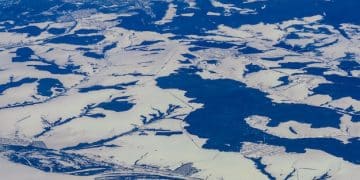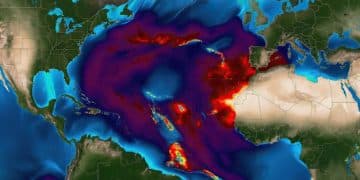US Temperature Rise: Latest Scientific Model Predictions
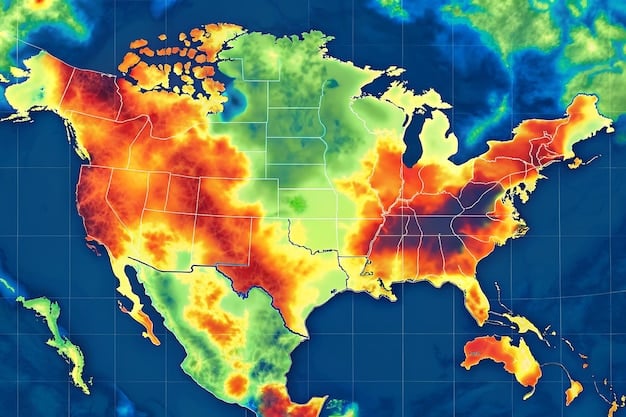
The latest scientific models predict that the United States will experience significant and accelerating temperature increases throughout the 21st century, primarily driven by continued greenhouse gas emissions, with varying regional impacts.
Understanding what are the latest scientific models predicting for future temperature increases in the US is crucial for preparedness and policy-making. Climate change is not a distant threat but a present reality, and these models offer a critical lens through which to view its unfolding impacts across the diverse landscapes of America. By delving into the sophisticated methodologies and complex data streams, we can better grasp the nuances of anticipated warming, region by region.
The Science Behind Climate Models: A Foundation for Prediction
Climate models are sophisticated computer simulations that represent the interactions of the atmosphere, oceans, land surface, and ice. These models are built upon fundamental laws of physics, chemistry, and biology, incorporating vast datasets to project future climate scenarios. They are not simple forecasts but rather complex tools for understanding how the Earth’s climate system might respond to various forcings, such as increasing greenhouse gas concentrations from human activities.
Developing a robust climate model involves a multidisciplinary approach, integrating insights from meteorology, oceanography, geochemistry, and glaciology. Scientists continuously refine these models by comparing their outputs against historical climate data, ensuring their accuracy and reliability. This iterative process of validation and improvement strengthens the confidence in their future projections, making them invaluable for informing climate policy and adaptation strategies.
Types of Models and Their Evolution
Several types of models contribute to our understanding of future climate. Global Climate Models (GCMs) provide broad-scale projections, while Regional Climate Models (RCMs) offer more localized detail, downscaling the GCM outputs to a finer resolution. Earth System Models (ESMs) represent an even more integrated approach, including biogeochemical cycles like the carbon cycle, which allows for a more comprehensive understanding of climate feedbacks.
- Global Climate Models (GCMs): Provide overarching future climate scenarios.
- Regional Climate Models (RCMs): Offer localized, detailed climate projections.
- Earth System Models (ESMs): Integrate complex biogeochemical cycles for holistic insights.
Over the decades, climate models have evolved significantly. Early models were relatively simple, focusing primarily on atmospheric dynamics. Today’s models are vastly more complex, incorporating intricate representations of ocean currents, cloud formation, land-surface interactions, and anthropogenic emissions. This continuous advancement, driven by increasing computational power and improved scientific understanding, has led to more precise and nuanced predictions.
The Coupled Model Intercomparison Project (CMIP) is an international endeavor that collects and compares the results from various climate models worldwide. This intercomparison allows scientists to assess the range of possible outcomes, identify robust patterns, and pinpoint areas of uncertainty. The CMIP framework is a cornerstone of climate science, providing the foundational data for reports by the Intergovernmental Panel on Climate Change (IPCC) and national assessments.
Understanding the capabilities and limitations of these models is paramount. While they provide robust projections, inherent uncertainties remain due to the chaotic nature of the climate system, the complexity of future human emissions, and the incomplete understanding of all feedback mechanisms. Nevertheless, the consistent message across a multitude of independent models lends strong credibility to their overarching predictions of warming.
Projected Temperature Increases Across US Regions
The United States is a vast and climatically diverse nation, meaning that future temperature increases will not be uniform. Scientific models consistently show that all regions of the US are projected to warm, but the rate and magnitude of this warming will vary significantly. These regional differences are influenced by factors such as geography, proximity to oceans, and existing climate patterns, which amplify or attenuate global warming trends.
Understanding these localized projections is vital for developing targeted climate resilience strategies, from agriculture to urban planning. The impacts of heat on human health, infrastructure, and natural ecosystems will differ based on the specific warming experienced in each region, necessitating tailored responses.
Northeast and Midwest: Rising Temperatures and Heatwaves
In the Northeast and Midwest, models predict significant increases in average temperatures, particularly during summer months. This warming will lead to more frequent and intense heatwaves, posing substantial risks to public health, energy grids, and agricultural productivity. The length of the warm season is also expected to extend, impacting growing seasons and increasing demand for cooling.
- Average Temperature Rise: Significant increases, especially in summer.
- Heatwave Frequency: More frequent and intense heatwave events.
- Season Length: Extended warm seasons and frost-free periods.
The potential for increased “humid heat” is also a concern for these regions, as higher temperatures coupled with elevated humidity levels can create extremely dangerous conditions. This combination impairs the body’s ability to cool itself through sweating, increasing the risk of heat stress and heatstroke. Cities, prone to the urban heat island effect, will likely experience even more pronounced warming.
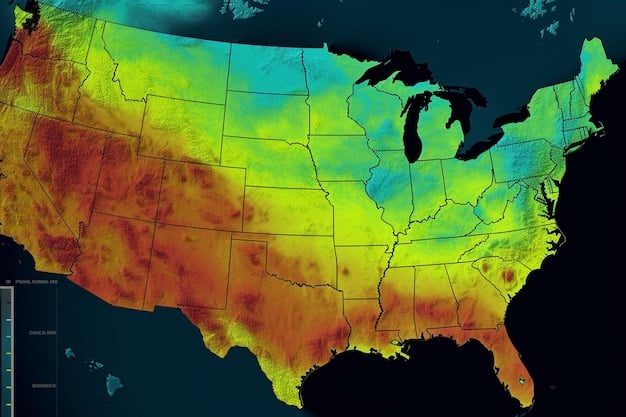
For agriculture, longer growing seasons might seem beneficial, but they also bring challenges, including increased pest pressure and higher water demands. The delicate balance of ecosystems within these regions will face increasing stress from altered seasonal patterns and extreme heat events. Infrastructure, particularly older systems, will need to be upgraded to withstand higher temperatures and reduce energy consumption.
Southeast and Southwest: Exacerbated Drought and Extreme Heat
The Southeast and Southwest are projected to face some of the most dramatic temperature increases, exacerbating existing climate challenges. For the Southwest, already a hot and arid region, models predict a drastic increase in extreme heat days and longer, more severe droughts. This will further strain water resources, increase the risk of wildfires, and impact biodiversity.
In the Southeast, rising temperatures will combine with high humidity, leading to oppressive heat index values. More intense heatwaves will threaten human health, particularly for vulnerable populations, and put immense pressure on energy infrastructure due to increased air conditioning demand. The duration of heat events is also expected to lengthen, providing little respite.
- Southwest: Increased extreme heat days, severe and prolonged droughts, higher wildfire risk.
- Southeast: Oppressive heat index values, increased health risks, strain on energy grids.
- Water Stress: Critical issue across both regions, impacting agriculture and urban centers.
The agricultural sectors in both regions, vital contributors to the national food supply, face significant disruption from these higher temperatures and altered precipitation patterns. Crops may suffer from heat stress, and water scarcity could force shifts in farming practices or even land use. Urban areas in these regions are already grappling with heat mitigation strategies, and the models indicate an urgent need for scaled-up efforts.
Ecosystems, particularly those adapted to specific temperature ranges, face severe threats. Coral reefs in the Southeast, for example, are highly vulnerable to ocean warming, while desert ecosystems in the Southwest could see shifts in species distribution and increased die-offs. The interplay of extreme heat and reduced water availability creates a complex and challenging scenario for adaptation in these regions.
Pacific Northwest and Alaska: Distinct Warming Trends
Even regions typically associated with cooler climates, like the Pacific Northwest and Alaska, are not immune to significant warming. The Pacific Northwest is projected to experience substantial increases in summer temperatures, contributing to more intense and longer-lasting heatwaves, similar to those already observed in recent years. This warming also affects snowpack levels, a critical water source for the region’s rivers and ecosystems.
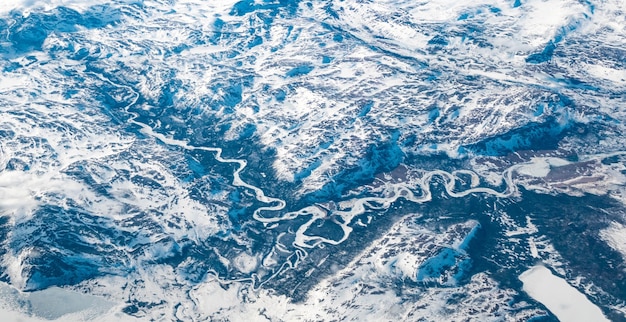
For Alaska, models predict disproportionately rapid warming, particularly in the Arctic and sub-Arctic regions. This amplified warming leads to accelerated permafrost thaw, causing infrastructure damage and releasing potent greenhouse gases (methane and CO2) that further contribute to global warming. Sea ice retreat also impacts indigenous communities and wildlife.
- Pacific Northwest: Increased summer heat, more intense heatwaves, reduced snowpack.
- Alaska: Disproportionately rapid warming, accelerated permafrost thaw, sea ice retreat.
- Ecosystem Impacts: Changes in forest health, wildlife migration, and traditional livelihoods.
The implications for the Pacific Northwest extend to unique forest ecosystems, which are becoming more susceptible to wildfires due to drier conditions and higher temperatures. Changes in river temperatures can also impact salmon populations, a cornerstone of the region’s economy and cultural heritage. The cascading effects of warming require comprehensive management of natural resources.
In Alaska, the rapid environmental changes threaten not only infrastructure but also traditional ways of life for indigenous populations who depend on stable ecosystems and ice conditions. The melting glaciers contributes to global sea-level rise, while changes in ocean temperatures impact marine life. The models underscore the urgency of addressing Arctic warming as a global issue with local consequences.
Uncertainties and Scenarios: Understanding the Range of Predictions
While climate models provide robust projections, it’s essential to understand the inherent uncertainties and the various scenarios used to frame future predictions. These uncertainties stem from several factors, including the natural variability of the climate system, limitations in our understanding of certain feedback loops, and, crucially, the unknown trajectory of future human emissions of greenhouse gases.
Scientists address these uncertainties by developing different “Representative Concentration Pathways” (RCPs) or, more recently, “Shared Socioeconomic Pathways” (SSPs). These pathways represent a range of possible future emission trajectories, from aggressive mitigation scenarios to high-emissions “business-as-usual” scenarios. Each pathway results in a different warming outcome, illustrating the direct link between human choices and future climate.
High-Emissions vs. Low-Emissions Scenarios
Under a high-emissions scenario (e.g., SSP5-8.5), which assumes continued reliance on fossil fuels and minimal climate policy, the models predict significantly higher temperature increases across the US. This pathway leads to more extreme and widespread impacts, pushing climate systems beyond adaptation capabilities in many areas. The frequency and intensity of heatwaves, droughts, and other extreme weather events are projected to escalate dramatically.
Conversely, a low-emissions scenario (e.g., SSP1-2.6), which involves aggressive global efforts to reduce greenhouse gas emissions, shows a substantially more moderate warming. While some warming is unavoidable due to historical emissions, this pathway allows for more manageable impacts and greater opportunities for adaptation. The difference between these scenarios highlights the profound influence of current and future policy decisions.
- High-Emissions (e.g., SSP5-8.5): Significant temperature increases, more extreme and widespread impacts.
- Low-Emissions (e.g., SSP1-2.6): More moderate warming, manageable impacts, greater adaptation potential.
- Policy Impact: Direct link between emission choices and future climate outcomes.
Natural climate variability, such as El Niño/La Niña cycles and ocean oscillations, also introduces short-term fluctuations that can temporarily mask or amplify long-term warming trends. While models account for these oscillations, their exact timing and magnitude can add complexity to year-to-year predictions, though the long-term trend remains clear.
Feedback loops, such as the melting of permafrost releasing methane or changes in cloud cover altering Earth’s albedo, are areas of ongoing research. While models incorporate the best current understanding of these processes, their precise magnitude and timing contribute to the remaining uncertainties. Despite these complexities, the fundamental physics driving warming are well-understood, and the models consistently project a warmer future without significant emissions reductions.
Impacts Beyond Average Temperatures: A Holistic View
While average temperature increases are a primary indicator of climate change, the impacts extend far beyond simple numerical shifts. The latest scientific models also predict significant changes in other critical climate variables, which will have cascading effects on ecosystems, human health, infrastructure, and the economy across the United States. A holistic view considers these interconnected impacts.
Understanding these broader changes is essential for comprehensive planning and building resilience. Temperature increases amplify many pre-existing vulnerabilities, leading to more frequent and intense extreme weather events, altered precipitation patterns, and rising sea levels. These combined pressures create a complex web of challenges for communities nationwide.
Extreme Weather Events and Precipitation Changes
One of the most consequential predictions from climate models is the increase in the frequency and intensity of extreme weather events. This includes more severe heatwaves, as detailed previously, but also changes in precipitation. Some regions of the US are projected to experience more intense rainfall events, leading to increased flooding risks, even as overall annual precipitation might not change significantly.
Conversely, other regions, particularly the Southwest and parts of the Great Plains, are projected to face more prolonged and severe droughts. These shifts in precipitation patterns have profound implications for water availability, agriculture, and wildfire risk. The concept of “weather whiplash,” where periods of extreme drought are followed by intense rainfall, is also a growing concern.
- Heatwaves: More frequent and intense across most regions.
- Heavy Rainfall: Increased intensity, leading to higher flood risks in some areas.
- Drought: More prolonged and severe droughts in arid and semi-arid regions.
The models also suggest an increase in the intensity of tropical cyclones (hurricanes) due to warmer ocean waters, though not necessarily an increase in their frequency. Stronger hurricanes mean greater potential for wind damage, storm surge, and inland flooding, particularly along the Gulf and Atlantic coasts. The compounding effects of these extreme events pose significant challenges to emergency services and recovery efforts.
The disruption to the hydrological cycle has far-reaching consequences. Snowpack in mountain regions, a natural water reservoir, is projected to diminish, impacting downstream water supplies for agriculture and urban centers. Changes in soil moisture content can also affect agricultural productivity and the susceptibility of forests to disease and pests. These interconnected changes highlight the pervasive nature of climate change impacts.
Sea Level Rise and Coastal Impacts
Concurrent with rising temperatures, scientific models project significant sea level rise along all US coastlines. This rise is primarily driven by two factors: the thermal expansion of ocean water as it warms, and the melting of glaciers and ice sheets. Even under low-emissions scenarios, some degree of sea level rise is inevitable due to the slow response of oceans and ice masses to past warming.
The impacts of sea level rise are diverse and severe. Coastal communities face increased risks from permanent inundation of low-lying areas, more frequent and higher-tide flooding (“nuisance flooding”), and enhanced storm surge during extreme weather events. This threatens critical infrastructure, coastal ecosystems, and property values.
- Coastal Inundation: Permanent submergence of low-lying coastal lands.
- Nuisance Flooding: More frequent non-storm related high-tide flooding.
- Storm Surge: Amplified impact of storm surges during hurricanes and severe storms.
Saltwater intrusion into freshwater aquifers is another growing concern, impacting drinking water supplies and agricultural land near the coast. Estuaries and coastal wetlands, vital nurseries for marine life and natural buffers against storms, are also highly vulnerable to sea level rise and increased salinity, potentially leading to widespread ecosystem collapse.
The rate of sea level rise is not uniform globally, nor along the US coast. Regional factors such as land subsidence or uplift, ocean currents, and localized gravitational effects from melting ice sheets can influence the localized rate of rise. Therefore, coastal adaptation strategies must be tailored to specific regional projections, accounting for these nuances. The long-term nature of sea level rise means that even small, incremental changes now will accumulate into significant impacts in the coming decades and centuries, requiring proactive and sustained planning.
Mitigation and Adaptation: Responding to Model Predictions
The scientific models predicting future temperature increases in the US serve as a powerful call to action. Their projections highlight the urgent need for both mitigation—reducing greenhouse gas emissions—and adaptation—adjusting to the inevitable impacts of a changing climate. These two approaches are complementary and equally vital in building a resilient future.
Mitigation efforts aim to alter the highest-emissions scenarios, thus limiting the ultimate extent of warming and its most severe consequences. Adaptation, on the other hand, recognizes that some level of warming and its associated impacts are already locked in due to past emissions, and therefore, communities must prepare to cope with these unavoidable changes.
Policy Implications and Emission Reductions
The most direct way to influence future temperature increases is through aggressive global emission reductions. This involves transitioning away from fossil fuels to renewable energy sources, improving energy efficiency across all sectors, and enhancing carbon sequestration through land management practices. Policy frameworks at federal, state, and local levels play a critical role in incentivizing and regulating this transition.
Governments can implement carbon pricing mechanisms, invest in renewable energy infrastructure, set stricter emissions standards for vehicles and industries, and promote sustainable land use. International cooperation is also essential, as climate change is a global problem requiring coordinated efforts. The pathways outlined by the SSPs demonstrate the profound impact that such policy decisions can have on the future climate trajectory of the US and the world.
- Energy Transition: Shifting to renewable energy sources.
- Efficiency: Improving energy efficiency in buildings, transport, and industry.
- Carbon Sequestration: Enhancing natural carbon sinks through forestry and agriculture.
While the scale of transformation required is immense, the economic and health benefits of clean energy and reduced pollution are substantial. Innovation in green technologies and sustainable practices also presents significant opportunities for economic growth and job creation. The models repeatedly show that delayed action significantly increases the cost and difficulty of both mitigation and adaptation.
Public awareness and political will are crucial for driving these policy changes. Educating the public about the scientific consensus and the predicted impacts can foster greater support for ambitious climate action. The scientific community’s continuous refinement of models provides ever-clearer evidence, empowering policymakers with the data needed to make informed decisions about emission reduction targets and strategies.
Adaptation Strategies and Building Resilience
Even with successful mitigation, the US will need to adapt to a warmer climate. Adaptation strategies involve a wide range of measures tailored to specific regional impacts. For coastal communities, this might mean constructing sea walls, restoring coastal wetlands, or even managed retreat from vulnerable areas. For regions facing increased heat, strategies include expanding green spaces, implementing cool pavement technologies, and improving early warning systems for heatwaves.
Water management will become increasingly critical, especially in the Western US. This includes investing in water conservation technologies, diversifying water sources (e.g., through desalination where feasible), and improving infrastructure to capture and store precipitation more efficiently. Agricultural practices will also need to adapt, potentially through shifts to more heat-tolerant crops or drought-resistant farming methods.
- Coastal Protection: Sea walls, wetland restoration, and strategic relocation.
- Urban Heat Mitigation: Green infrastructure, cool roofs/pavements.
- Water Management: Conservation, diverse sources, efficient infrastructure.
Resilience building also extends to public health systems, which need to prepare for increased heat-related illnesses and shifts in disease vectors. Emergency services must be equipped to handle more frequent and intense extreme weather events. Infrastructure, from roads to power grids, requires robust design and maintenance to withstand higher temperatures, heavier rainfall, and stronger storms.
Community engagement and local planning are vital for effective adaptation. Resilience is not just about large-scale infrastructure projects but also about empowering communities to understand their local risks and participate in developing tailored solutions. The latest scientific models provide the foundational data for these critical conversations and for pinpointing where resources and efforts should be prioritized to reduce vulnerability and enhance the nation’s capacity to thrive in a changing climate.
| Key Prediction | Brief Description |
|---|---|
| 🌡️ Regional Warming | All US regions projected to warm, with varying intensity, particularly in the Southwest and Arctic. |
| 🔥 Extreme Heat | Increased frequency and intensity of heatwaves across most of the country. |
| 💧 Water Stress | More intense droughts in some areas, heavier rainfall/flooding in others, affecting water resources. |
| 🌊 Sea Level Rise | Significant rise along all coastlines, increasing coastal flooding and storm surge risks. |
Frequently Asked Questions About US Temperature Predictions
▼
Climate models are complex computer programs based on fundamental physical laws that simulate Earth’s climate system. They are validated against historical data and are considered highly reliable for projecting long-term climate trends, though precise short-term forecasts remain challenging. Their consistent predictions across multiple independent models enhance their credibility.
▼
No, temperature increases will vary significantly by region due to local factors like geography, proximity to oceans, and existing climate patterns. While all regions are projected to warm, some, like the Southwest and Alaska, are expected to experience disproportionately higher increases compared to others.
▼
Different emissions scenarios (e.g., SSPs) represent varying levels of future greenhouse gas emissions. High-emissions scenarios predict significantly greater warming and impacts, while low-emissions scenarios, involving aggressive reductions, project more moderate and manageable temperature increases. This highlights the profound effect of human policy choices.
▼
Beyond average temperature changes, models predict more extreme heatwaves, shifts in precipitation patterns (increased droughts in some areas, heavier rainfall elsewhere), and significant sea level rise affecting coastal regions. These changes will also impact ecosystems, infrastructure, public health, and agricultural productivity across the nation.
▼
Responding requires both mitigation (reducing greenhouse gas emissions through renewable energy transition and efficiency) and adaptation (adjusting to unavoidable impacts via strategies like coastal protection, water management, and urban greening). Both approaches are crucial for building resilience and limiting the severity of future climate changes.
Conclusion
The latest scientific models provide a clear and compelling picture of future temperature increases across the United States. While the precise magnitude and regional distribution of warming depend on future emission trajectories, the overarching message is one of significant and widespread change. These projections, built on decades of research and validated data, underscore the urgency of comprehensive action. From rising sea levels and intensified heatwaves to altered precipitation patterns and increased risk of wildfires, the impacts are deeply interconnected and demand integrated solutions. By understanding these predictions, policymakers, communities, and individuals can better prepare, adapt, and most importantly, work towards mitigating the extent of climate change, safeguarding the future of the nation and its diverse landscapes for generations to come. The science is robust, and the call to action is unequivocal, emphasizing that informed choices today will define the climate reality of tomorrow.


